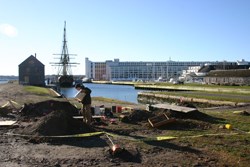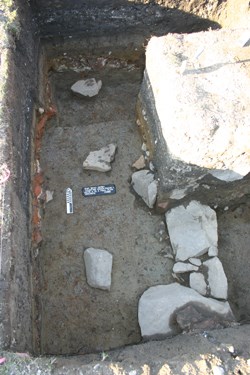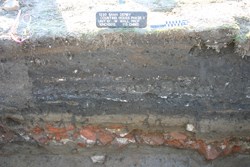|
The Excavations at the Derby Counting House 
Photograph by Andrew Sewell, Hardlines Design Company
The findings of the archaeologists firmly support the documentary evidence about the building. At the top, they found layers of twentieth century fill, probably placed by the National Park Service to even out the grade of Derby Wharf. Below that, however, they found several layers of earth and artifacts that dated to the eighteenth and nineteenth centuries. 
Photograph by Andrew Sewell, Hardlines Design Company
Cushing getting "the rocks" might also account for the fact that only a partial foundation was found. Enough remained, however, to determine the east side of the building. 
Photograph by Andrew Sewell, Hardlines Design Company
Throughout the layers of fill, the archaeologists found many small sherds of ceramics. These tiny artifacts help to tell us about what was being used in the houses and businesses of Salem in the 18th and 19th centuries. By themselves, some of these bits of ceramic are so small that they might not seem to contain any information, but at Salem Maritime, we are lucky to have one of the best archaeological collections in Salem, from the backyard of the Narbonne House at the site. Because the garbage pits were found behind the Narbonne House, we have many nearly complete vessels that were used in a middle-class house in Salem. What follows are a few of the best examples of ceramic sherds from the Derby Counting House, side-by-side-with their counterparts from the Narbonne House.

NPS collections
The polychrome sherd on the left bears a striking stylistic resemblance to the saucer on the right, which is an example of hand painted pearlware made in England from about 1795-1815.

NPS collection
The tiny sherd on the left is the rim of a vessel -it is too small to determine if it is a plate, bowl, saucer, or cup-that had a blue edge to the rim, much like the bowl fragment on the right from the Narbonne House. This blue-edged pearlware from England was extremely popular in the early nineteenth century as everyday dishes for a wide variety of households. 
NPS collections
Redware, which was made locally in Massachusetts, as well as in England, was used for everyday kitchen ware, and as jars for shipping and storage of foodstuffs and oils. Quite a few redware sherds were found in the layers of dirt contemporary with the Derby Counting House, indicating that these vessels were in common use (and often broken) on the wharves. The pieces shown here on the left are probably from a common jar, like the one on the right found in the Narbonne House Archaeology. These jars were generally only glazed on the inside to make them cheaper, and once the food was packed inside, they were sealed on the top by covering it with a fresh hog's bladder and tying it tightly with a piece of string under the lip. As the bladder dried, it created an airtight seal. |
Last updated: February 26, 2015
